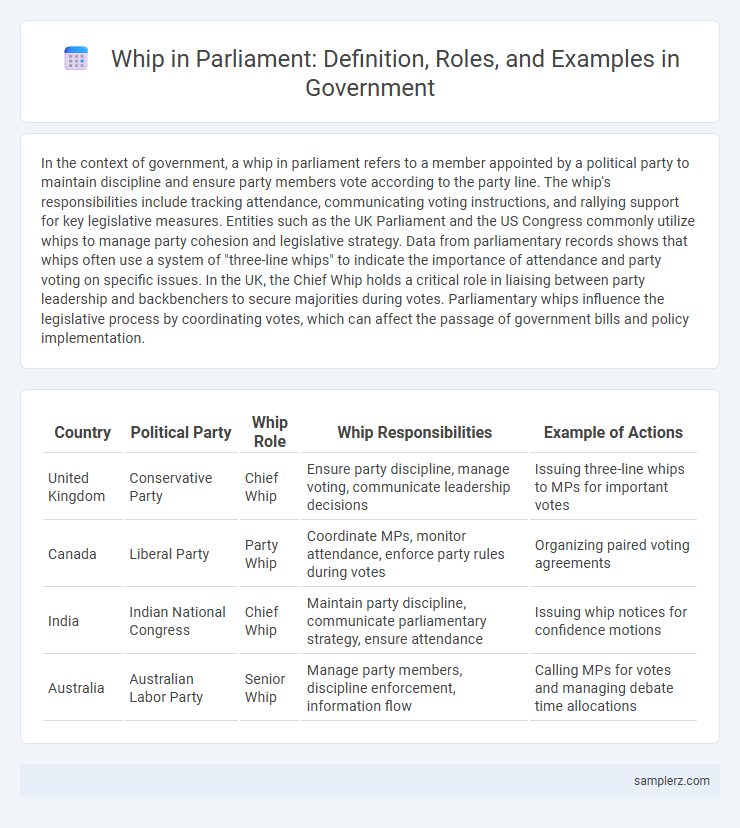In the context of government, a whip in parliament refers to a member appointed by a political party to maintain discipline and ensure party members vote according to the party line. The whip's responsibilities include tracking attendance, communicating voting instructions, and rallying support for key legislative measures. Entities such as the UK Parliament and the US Congress commonly utilize whips to manage party cohesion and legislative strategy. Data from parliamentary records shows that whips often use a system of "three-line whips" to indicate the importance of attendance and party voting on specific issues. In the UK, the Chief Whip holds a critical role in liaising between party leadership and backbenchers to secure majorities during votes. Parliamentary whips influence the legislative process by coordinating votes, which can affect the passage of government bills and policy implementation.
Table of Comparison
| Country | Political Party | Whip Role | Whip Responsibilities | Example of Actions |
|---|---|---|---|---|
| United Kingdom | Conservative Party | Chief Whip | Ensure party discipline, manage voting, communicate leadership decisions | Issuing three-line whips to MPs for important votes |
| Canada | Liberal Party | Party Whip | Coordinate MPs, monitor attendance, enforce party rules during votes | Organizing paired voting agreements |
| India | Indian National Congress | Chief Whip | Maintain party discipline, communicate parliamentary strategy, ensure attendance | Issuing whip notices for confidence motions |
| Australia | Australian Labor Party | Senior Whip | Manage party members, discipline enforcement, information flow | Calling MPs for votes and managing debate time allocations |
Understanding the Role of a Whip in Parliament
A whip in parliament is responsible for maintaining party discipline and ensuring members attend and vote according to party lines. They coordinate legislative strategies, communicate party positions, and manage member participation during crucial votes. Their role is vital for the smooth functioning of parliamentary proceedings and the consolidation of government power.
Historical Origins of the Parliamentary Whip
The parliamentary whip has its origins in the British House of Commons during the 18th century, where party leaders used a "whipper-in" to ensure attendance and voting discipline among members. Historical records from the 1750s illustrate the evolution of whips as key figures enforcing party unity and managing parliamentary business. This system spread to other Westminster-style parliaments, becoming integral to legislative procedure worldwide.
Key Functions of the Whip in Legislative Processes
The whip in parliament plays a critical role in maintaining party discipline by ensuring members attend and vote according to party lines, which is essential for passing legislation. They coordinate communication between party leadership and members, facilitating strategic planning during debates and votes. Monitoring attendance and managing vote counts enables the whip to influence legislative outcomes and uphold party cohesion.
How Whips Maintain Party Discipline
Whips in parliament maintain party discipline by ensuring members attend voting sessions and adhere to the party line during crucial votes. They communicate leadership's expectations, issue warnings, and use incentives or sanctions to secure compliance. This enforcement fosters unity and strengthens the party's influence on legislative outcomes.
Famous Examples of Whip Actions in Parliament
In the UK Parliament, the famous 1975 vote of no confidence against Prime Minister Harold Wilson saw the Conservative Whips skillfully ensuring party discipline to secure the opposition's success. In the Australian Parliament, the 2010 hung parliament featured intense whipping tactics to maintain coalition support, crucial for government formation. In India, during the 1975 Emergency period, the Congress Party Whips enforced strict party loyalty, preventing defections and consolidating Indira Gandhi's power.
The Impact of the Whip on Voting Behavior
The Whip in parliament plays a crucial role in shaping voting behavior by enforcing party discipline and ensuring members align with party policies during critical votes. By issuing voting instructions and monitoring attendance, the Whip increases the likelihood of cohesive party voting, which strengthens legislative outcomes and government stability. This influence directly impacts policy implementation and parliamentary decision-making efficiency, making the Whip indispensable in maintaining order and unity within political parties.
Case Study: Whip Enforcement in Major Bills
In the UK Parliament, the Conservative Party whip played a crucial role during the Brexit Withdrawal Agreement debates by strictly enforcing party discipline, resulting in a narrow party-line vote that passed the bill. Similarly, in the US House of Representatives, the majority whip's strategic vote counting and negotiation were pivotal in securing the passage of the Affordable Care Act despite internal party dissent. These cases illustrate how effective whip enforcement ensures legislative success by maintaining cohesion among party members on major bills.
Differences Between Chief Whip and Other Party Whips
The Chief Whip in parliament holds the primary responsibility for maintaining party discipline and ensuring members vote according to party lines, while other party whips assist in communication and vote counting within the party. Chief Whips coordinate strategy with the party leadership and play a crucial role in managing legislative agendas. In contrast, other whips focus on supporting roles, such as monitoring attendance and relaying instructions to rank-and-file members.
Consequences for MPs Ignoring the Whip
MPs ignoring the whip risk severe consequences including suspension from their party, loss of access to party resources, and removal from key parliamentary committees. Defying the whip can also tarnish an MP's reputation, diminish their influence within the party, and jeopardize future candidacy endorsements. Persistent rebellion may result in formal disciplinary actions or even expulsion from the parliamentary party group.
The Evolution of Whip Practices in Modern Parliaments
Whip practices in modern parliaments have evolved from simple vote counting to sophisticated systems of party discipline and communication. In the UK Parliament, the role of the Chief Whip now includes managing legislative priorities and maintaining party unity through digital coordination and real-time intelligence. This evolution reflects broader changes in parliamentary operations driven by technology and increasing political complexity.

example of whip in parliament Infographic
 samplerz.com
samplerz.com